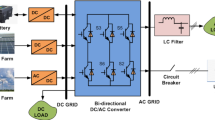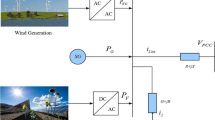Abstract
This paper presents a new adaptive water cycle algorithm (AWCA) to optimize the controllers operation in a multiple distributed generators (DGs)-based microgrid. The inconsistent nature of renewable-based DG creates several challenges to stability margin of microgrid. The proposed AWCA improves the stability margin and transient profile of multi-DGs-based microgrid during various bounded/unbounded uncertainties. AWCA includes a sinusoidal chaotic map to handle all the nonlinearities produced in the microgrid. A multiple DG-based IEEE 9-bus microgrid system is considered to validate the performance of the proposed AWCA. Wind-generating system (WS) and photovoltaic (PV) with auxiliary battery energy storage are integrated to the microgrid as different DGs. A diesel engine generator with Pade approximation-based governor control is incorporated to provide uninterrupted microgrid operation. Here, second-order phase-locked loop-based feedback controllers are used for the grid synchronization of the DGs. The controller parameters of rotor-side converter and grid-side converter of WS are optimized to provide a better power regulation at the PCC. Similarly, the PV-VSC controller parameters are optimized by AWCA to improve the overall operation of the microgrid by minimizing the loss and improving stability. The performance of the proposed AWCA is verified under different DG-side as well as microgrid uncertainties. The efficacy of the proposed AWCA is presented in terms of power oscillation damping and improved stability limits. The assessments are evaluated in MATLAB script and dSPACE 1104-based hardware-in-loop platforms.










Similar content being viewed by others
References
Saheb-Koussa D, Haddadi M, Belhamel M (2009) Economic and technical study of a hybrid system (wind–photovoltaic–diesel) for rural electrification in Algeria. Appl Energy 86(7–8):1024–1030
Hu J, Shan Y, Yinliang X, Guerrero JM (2019) A coordinated control of hybrid ac/dc microgrids with PV-wind-battery under variable generation and load conditions. Int J Electr Power Energy Syst 104:583–592
Naik J, Dhar S, Dash PK (2019) Adaptive differential relay coordination for PV DC microgrid using a new kernel based time-frequency transform. Int J Electr Power Energy Syst 106:56–67
Lima FKA, Luna A, Rodriguez P, Watanabe EH, Blaabjerg F (2009) Rotor voltage dynamics in the doubly fed induction generator during grid faults. IEEE Trans Power Electron 25(1):118–130
Adhikari S, Li F (2014) Coordinated Vf and PQ control of solar photovoltaic generators with MPPT and battery storage in microgrids. IEEE Trans Smart Grid 5(3):1270–1281
Martins FG (2005) Tuning PID controllers using the ITAE criterion. Int J Eng Educ 21(5):867
Michiels W, Niculescu S-I (2007) Stability and stabilization of time-delay systems: an eigenvalue-based approach. Society for Industrial and Applied Mathematics
Ambia MN, Hasanien HM, Al-Durra A, Muyeen SM (2014) Harmony search algorithm-based controller parameters optimization for a distributed-generation system. IEEE Trans Power Deliv 30(1):246–255
Swaminathan G, Ramesh V, Umashankar S, Sanjeevikumar P (2018) Investigations of microgrid stability and optimum power sharing using robust control of grid tie pv inverter. In: Advances in smart grid and renewable energy, Springer, Singapore, pp 379–387
Mohamed MA, Diab AAZ, Rezk H (2019) Partial shading mitigation of PV systems via different meta-heuristic techniques. Renew Energy 130:1159–1175
Mao M, Duan Q, Duan P, Bei H (2018) Comprehensive improvement of artificial fish swarm algorithm for global MPPT in PV system under partial shading conditions. Trans Inst Meas Control 40(7):2178–2199
Dhar S, Dash PK (2016) A new backstepping finite time sliding mode control of grid connected PV system using multivariable dynamic VSC model. Int J Electr Power Energy Syst 82:314–330
Patnaik RK, Dash PK, Mahapatra K (2016) Adaptive terminal sliding mode power control of DFIG based wind energy conversion system for stability enhancement. Int Trans Electr Energy Syst 26(4):750–782
Saffari M, de Gracia A, Fernández C, Belusko M, Boer D, Cabeza LF (2018) Optimized demand side management (DSM) of peak electricity demand by coupling low temperature thermal energy storage (TES) and solar PV. Appl Energy 211:604–616
Anand I, Senthilkumar S, Biswas D, Kaliamoorthy M (2018) Dynamic power management system employing a single-stage power converter for standalone solar PV applications. IEEE Trans Power Electron 33(12):10352–10362
Suresh M, Meenakumari R (2018) Optimal Planning of solar PV/WTG/DG/battery connected integrated renewable energy systems for residential applications using hybrid optimization. Int J Indu Eng 2(1):15–20
Mahdavi S, Hemmati R, Jirdehi MA (2018) Two-level planning for coordination of energy storage systems and wind-solar-diesel units in active distribution networks. Energy 151:954–965
Soliman MA, Hasanien HM, Azazi HZ, El-kholy EE, Mahmoud SA (2018) Hybrid ANFIS-GA-based control scheme for performance enhancement of a grid-connected wind generator. IET Renew Power Gener 12(7):832–843
Mohamed AAS, Berzoy A, Mohammed OA (2016) Design and hardware implementation of FL-MPPT control of PV systems based on GA and small-signal analysis. IEEE Trans Sustain Energy 8(1):279–290
Wang S-C, Liu Y-H (2014) A PSO-based fuzzy-controlled searching for the optimal charge pattern of Li-ion batteries. IEEE Trans Indu Electron 62(5):2983–2993
Panda S, Padhy NP, Patel RN (2008) Power-system stability improvement by PSO optimized SSSC-based damping controller. Electr Power Compon Syst 36(5):468–490
Mohammadi S, Soleymani S, Mozafari B (2014) Scenario-based stochastic operation management of microgrid including wind, photovoltaic, micro-turbine, fuel cell and energy storage devices. Int J Electr Power Energy Syst 54:525–535
Satapathy P, Dhar S, Dash PK (2017) Stability improvement of PV-BESS diesel generator-based microgrid with a new modified harmony search-based hybrid firefly algorithm. IET Renew Power Gen 11(5):566–577
Mohammadi S, Mozafari B, Solimani S, Niknam T (2013) An adaptive modified firefly optimisation algorithm based on hong’s point estimate method to optimal operation management in a microgrid with consideration of uncertainties. Energy 51:339–348
Deihimi A, Zahed BK, Iravani R (2016) An interactive operation management of a micro-grid with multiple distributed generations using multi-objective uniform water cycle algorithm. Energy 106:482–509
Mishra SP, Dhar S, Dash PK (2019) An effective battery management scheme for wind energy systems using multi Kernel Ridge regression algorithm. J Energy Storage 21:418–434
Zhang J, Yihong W, Guo Y, Wang B, Wang H, Liu H (2016) A hybrid harmony search algorithm with differential evolution for day-ahead scheduling problem of a microgrid with consideration of power flow constraints. Appl Energy 183:791–804
Author information
Authors and Affiliations
Corresponding author
Additional information
Publisher's Note
Springer Nature remains neutral with regard to jurisdictional claims in published maps and institutional affiliations.
Rights and permissions
About this article
Cite this article
Dash, P.K., Nayak, P., Satapathy, P. et al. Optimal control of PV–WS battery-based microgrid using an adaptive water cycle technique. Electr Eng 102, 2193–2210 (2020). https://doi.org/10.1007/s00202-020-01027-1
Received:
Accepted:
Published:
Issue Date:
DOI: https://doi.org/10.1007/s00202-020-01027-1




